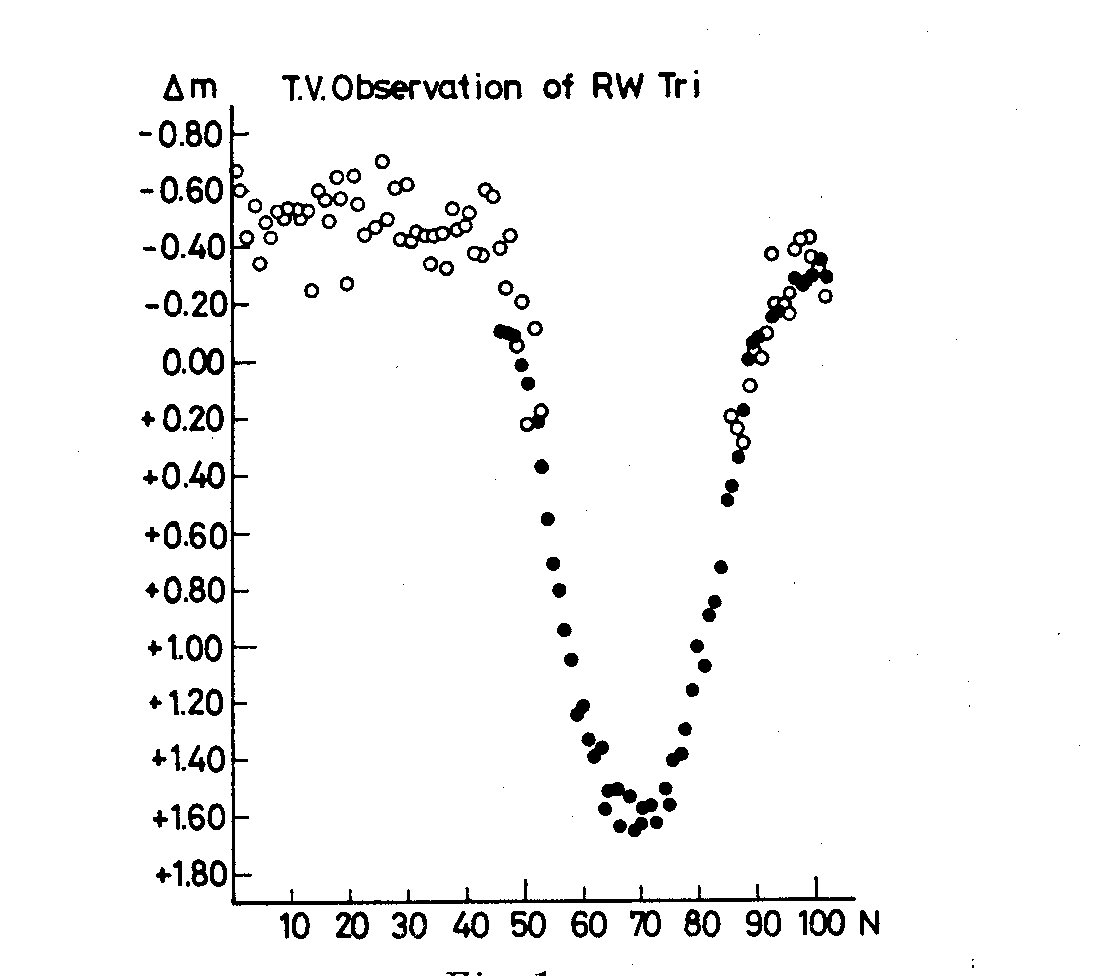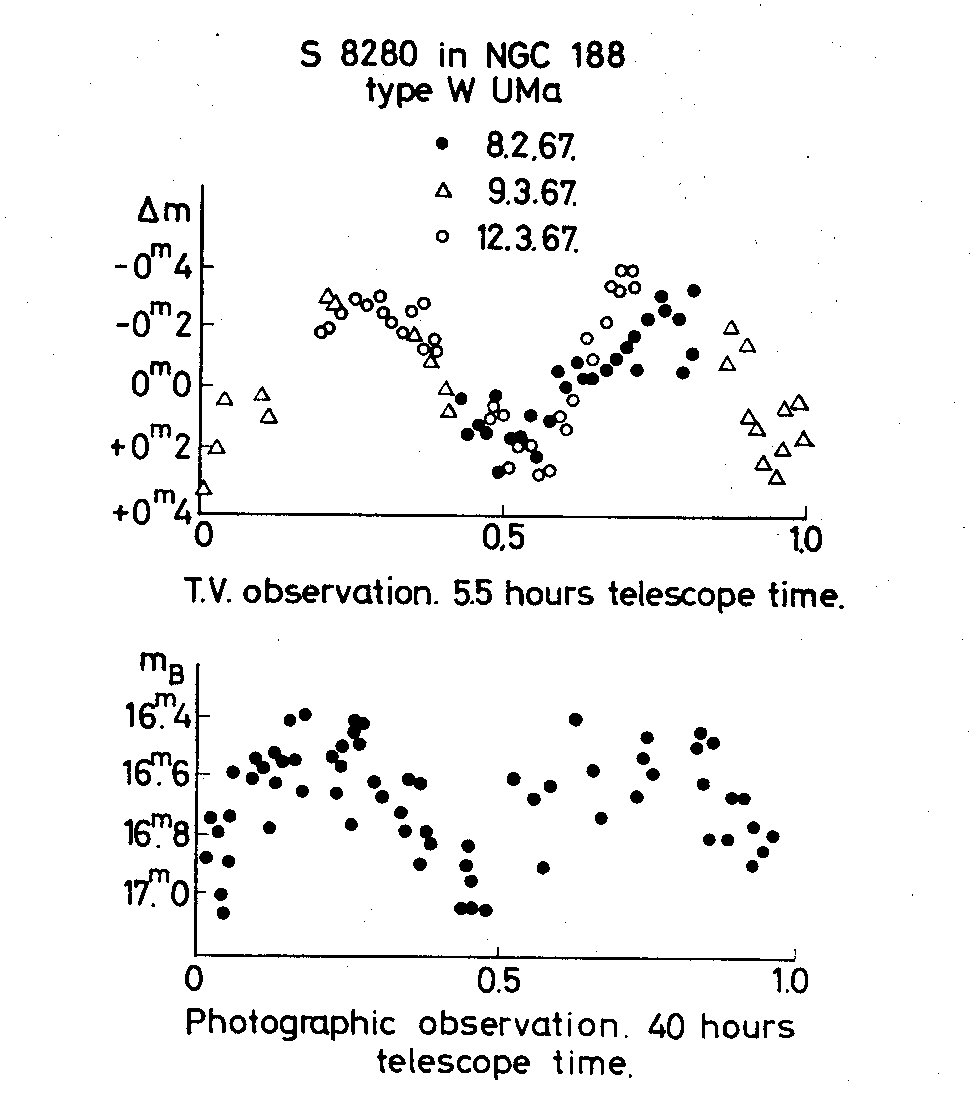Non-Periodic Phenomena in Variable Stars
IAU Colloquium, Budapest, 1968
ABOUT THE T. V. PHOTOMETRY OF FAINT VARIABLE STARS
A. N. ABRAMENKO and V. V. PROKOFJEVA
Crimean Astrophysical Observatory, USSR
At the Crimean Astrophysical Observatory of the USSR a television
equipment is employed for the measurement of stellar brightness using a
high sensitive image-orthycon and a two cascade image tube. We can
detect faint stars of the 20th and the 21st magnitude with the 0.5 meter
telescope and with an exposure time of only 10-60 sec. (Abramenko et al.
1964.) Two methods of measuring T. V. image photos of stars are used.
One of them is to measure the diameter of the images. This method is
used for bright stars and has a range of 5-7 magnitudes (Abramenko and
Prokofjeva, 1967). The other one is to measure the optical density or
the transparency of the images of stars. This method is used for faint
stars and has the range of 2-3 magnitudes. Observing variable stars we
have an accuracy of 0.10-0.15 and 0.06-0.10 magnitude using the first
and second method, respectively. Thus the full range of measurements in
one T. V. photo is about 9 magnitudes and the accuracy is not worse than
in the case of ordinary photography. Several variable stars have been
observed. Fig. 1 shows the changes of brightness of RW Tri during one
eclipse on 30 Dec. 1966 (Efimov and Prokofjeva, 1968). The observations
were made with the 0.5 meter coudé telescope. The exposure time was 20 sec.
The brightness of the star in eclipse was about 16 magnitude. In 20 minutes
the brightness of the star decreased two magnitudes. The measurements were
made by two methods: by the measurement of diameters when the star was bright
(open circles) and by the measurement of optical density when the star
was faint (dots).
Fig., 2 shows the results of T. V. observations of S 8280 in NGC 188, a
variable of type W UMa (Istomin, 1967). During 5.5 hours in 3 different
nights about 400 photos were obtained, each with an exposure time of 40
sec. One point in Fig. 2. corresponds to the average value of 5 measurements.
Below there are results of ordinary photographic observations which were made
for the same star with a telescope having the same diameter. About 50
measurements of the light were made during 40 hours of telescope-time.
 Fig. 1
Fig. 1
 Fig. 2
T. V. observations need less telescope-time than ordinary photographic
observations. Owing to the great number of T. V. photos we can easily
register the changes of the light curve of nonstable stars.
REFERENCES
Abramenko, A. N. et al., 1964, Izv. Krym. astrofiz. Obs. 33, 315.
Abramenko, A. N. and Prokofjeva, V. V., 1967, Izv. Krym. astrofiz. Obs. 36, 289.
Efimov, J. S. and Prokofjeva, V. V., 1968, Izv. Krym astrofiz. Obs. 39.
Istomin, L. F., 1967, Astr. Cirk. Izdav. bjuro astr. Soobsc, Kazan, No. 448.
Fig. 2
T. V. observations need less telescope-time than ordinary photographic
observations. Owing to the great number of T. V. photos we can easily
register the changes of the light curve of nonstable stars.
REFERENCES
Abramenko, A. N. et al., 1964, Izv. Krym. astrofiz. Obs. 33, 315.
Abramenko, A. N. and Prokofjeva, V. V., 1967, Izv. Krym. astrofiz. Obs. 36, 289.
Efimov, J. S. and Prokofjeva, V. V., 1968, Izv. Krym astrofiz. Obs. 39.
Istomin, L. F., 1967, Astr. Cirk. Izdav. bjuro astr. Soobsc, Kazan, No. 448.
 Fig. 1
Fig. 1
 Fig. 2
T. V. observations need less telescope-time than ordinary photographic
observations. Owing to the great number of T. V. photos we can easily
register the changes of the light curve of nonstable stars.
REFERENCES
Abramenko, A. N. et al., 1964, Izv. Krym. astrofiz. Obs. 33, 315.
Abramenko, A. N. and Prokofjeva, V. V., 1967, Izv. Krym. astrofiz. Obs. 36, 289.
Efimov, J. S. and Prokofjeva, V. V., 1968, Izv. Krym astrofiz. Obs. 39.
Istomin, L. F., 1967, Astr. Cirk. Izdav. bjuro astr. Soobsc, Kazan, No. 448.
Fig. 2
T. V. observations need less telescope-time than ordinary photographic
observations. Owing to the great number of T. V. photos we can easily
register the changes of the light curve of nonstable stars.
REFERENCES
Abramenko, A. N. et al., 1964, Izv. Krym. astrofiz. Obs. 33, 315.
Abramenko, A. N. and Prokofjeva, V. V., 1967, Izv. Krym. astrofiz. Obs. 36, 289.
Efimov, J. S. and Prokofjeva, V. V., 1968, Izv. Krym astrofiz. Obs. 39.
Istomin, L. F., 1967, Astr. Cirk. Izdav. bjuro astr. Soobsc, Kazan, No. 448.